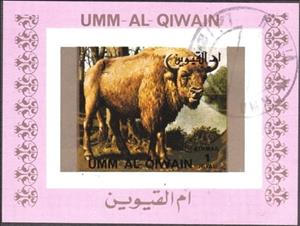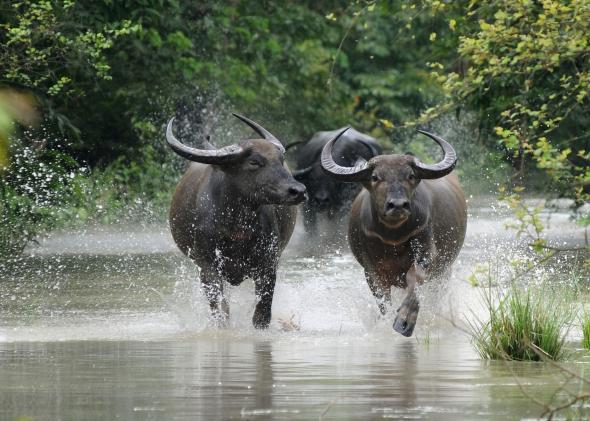Souvenir Sheet: European Bison (Bison bonasus) (Umm al-Qiwain 1972)
European Bison (Bison bonasus) (Umm al-Qiwain 1972)
01 January (Umm al-Qiwain ) within release Rare animals; large format goes into circulation Souvenir Sheet European Bison (Bison bonasus) face value 1 United Arab Emirates riyal
| Souvenir Sheet European Bison (Bison bonasus) in catalogues | |
|---|---|
| Michel: | Mi:UM BL1530B |
Souvenir Sheet is square format.
Also in the issue Rare animals; large format:
- Souvenir Sheet - Giant Panda (Ailuropoda melanoleuca) face value 1;
- Souvenir Sheet - European Bison (Bison bonasus) face value 1;
- Stamp - Fauna face value 1;
- Stamp - Fauna face value 1;
- Souvenir Sheet - Fauna face value 1;
- Souvenir Sheet - Fauna face value 1;
- Souvenir Sheet - Fauna face value 1;
- Souvenir Sheet - Fauna face value 1;
- Stamp - Fauna face value 1;
- Souvenir Sheet - Fauna face value 1;
- Stamp - Koala (Phascolarctos cinereus) face value 1;
- Stamp - Fauna face value 1;
- Souvenir Sheet - Sable Antelope (Hippotragus niger) face value 1;
- Souvenir Sheet - Fauna face value 1;
- Souvenir Sheet - Black Rhinoceros (Diceros bicornis) face value 1;
- Stamp - Fauna face value 1;
- Stamp - Fauna face value 1;
- Souvenir Sheet - Dromedary (Camelus dromedarius) face value 1;
- Souvenir Sheet - Cheetah (Acinonyx jubatus) face value 1;
- Souvenir Sheet - Arabian Oryx (Oryx leucoryx) face value 1;
- Souvenir Sheet - Chinchilla (Chinchilla sp.) face value 1;
- Souvenir Sheet - Black Rhinoceros (Diceros bicornis) face value 1;
- Souvenir Sheet - Markhor (Capra falconeri) face value 1;
- Souvenir Sheet - Tasmanian Tiger (Thylacinus cynocephalus) face value 1;
- Souvenir Sheet - Spectacled Bear (Tremarctos ornatus) face value 1;
- Souvenir Sheet - Fauna face value 1;
- Souvenir Sheet - Sea Lion face value 1;
- Souvenir Sheet - Dromedary (Camelus dromedarius) face value 1;
- Souvenir Sheet - Cheetah (Acinonyx jubatus) face value 1;
- Souvenir Sheet - Lemur face value 1;
- Souvenir Sheet - Sable Antelope (Hippotragus niger) face value 1;
- Souvenir Sheet - Black-footed Ferret (Mustela nigripes) face value 1;
- Souvenir Sheet - Sumatran Orangutan (Pongo sp.) face value 1;
- Souvenir Sheet - Koala (Phascolarctos cinereus) face value 1;
- Souvenir Sheet - Kudu face value 1;
- Souvenir Sheet - Giant Panda (Ailuropoda melanoleuca) face value 1;
- Souvenir Sheet - Polar Bear (Ursus maritimus) face value 1;
- Souvenir Sheet - Sea Lion face value 1;
- Souvenir Sheet - Giant Panda (Ailuropoda melanoleuca) face value 1;
- Souvenir Sheet - Tiger (Panthera tigris) face value 1;
- Souvenir Sheet - Tasmanian wolf face value 1;
- Souvenir Sheet - Walrus (Odobenus rosmarus) face value 1;
- Souvenir Sheet - Sable Antelope (Hippotragus niger) face value 1;
- Souvenir Sheet - Gaur (Bos gaurus) face value 1;
- Souvenir Sheet - Arabian Oryx (Oryx leucoryx) face value 1;
- Souvenir Sheet - Przewalski’s Horse (Equus przewalskii) face value 1;
- Souvenir Sheet - Eurasian Lynx (Lynx lynx) face value 1;
- Souvenir Sheet - Polar Bear (Ursus maritimus) face value 1;
- Souvenir Sheet - Mantled Guereza (Colobus guereza) face value 1;
- Souvenir Sheet - Przewalski’s Horse (Equus przewalskii) face value 1;
- Souvenir Sheet - Eurasian Lynx (Lynx lynx) face value 1;
- Souvenir Sheet - Fauna face value 1;
- Souvenir Sheet - Mantled Guereza (Colobus guereza) face value 1;
- Souvenir Sheet - Zebra (Equus sp.) face value 1;
- Souvenir Sheet - Kudu face value 1;
- Souvenir Sheet - Tiger (Panthera tigris) face value 1;
- Souvenir Sheet - Black Rhinoceros (Diceros bicornis) face value 1;
- Souvenir Sheet - Zebra (Equus sp.) face value 1;
- Souvenir Sheet - Red Deer (Cervus elaphus) face value 1;
- Souvenir Sheet - Onager (Equus hemionus onager) face value 1;
- Souvenir Sheet - Onager (Equus hemionus onager) face value 1;
- Souvenir Sheet - Kudu face value 1;
- Souvenir Sheet - Walrus (Odobenus rosmarus) face value 1;
- Souvenir Sheet - Zebra (Equus sp.) face value 1;
- Souvenir Sheet - Arabian Oryx (Oryx leucoryx) face value 1;
- Souvenir Sheet - Sea Lion face value 1;
- Souvenir Sheet - Mantled Guereza (Colobus guereza) face value 1;
Souvenir Sheet European Bison (Bison bonasus) it reflects the thematic directions:
Mammals are any vertebrates within the class Mammalia (/məˈmeɪli.ə/ from Latin mamma "breast"), a clade of endothermic amniotes distinguished from reptiles (including birds) by the possession of a neocortex (a region of the brain), hair, three middle ear bones and mammary glands. All female mammals nurse their young with milk, secreted from the mammary glands. Mammals include the largest animals on the planet, the great whales. The basic body type is a terrestrial quadruped, but some mammals are adapted for life at sea, in the air, in trees, underground or on two legs. The largest group of mammals, the placentals, have a placenta, which enables the feeding of the fetus during gestation. Mammals range in size from the 30–40 mm (1.2–1.6 in) bumblebee bat to the 30-meter (98 ft) blue whale. With the exception of the five species of monotreme (egg-laying mammals), all modern mammals give birth to live young. Most mammals, including the six most species-rich orders, belong to the placental group. The largest orders are the rodents, bats and Soricomorpha (shrews and allies). The next three biggest orders, depending on the biological classification scheme used, are the Primates (apes and monkeys), the Cetartiodactyla (whales and even-toed ungulates), and the Carnivora (cats, dogs, seals, and allies).
A bison (pl.: bison) is a large bovine in the genus Bison (Greek: "wild ox" (bison)) within the tribe Bovini. Two extant and numerous extinct species are recognised.
Of the two surviving species, the American bison, B. bison, found only in North America, is the more numerous. Although colloquially referred to as a buffalo in the United States and Canada, it is only distantly related to the true buffalo. The North American species is composed of two subspecies, the Plains bison, B. b. bison, and the wood bison, B. b. athabascae, which is the namesake of Wood Buffalo National Park in Canada. A third subspecies, the eastern bison (B. b. pennsylvanicus) is no longer considered a valid taxon, being a junior synonym of
Animals are multicellular, eukaryotic organisms of the kingdom Animalia (also called Metazoa). All animals are motile, meaning they can move spontaneously and independently, at some point in their lives. Their body plan eventually becomes fixed as they develop, although some undergo a process of metamorphosis later on in their lives. All animals are heterotrophs: they must ingest other organisms or their products for sustenance.
Bubalina is a subtribe of wild cattle that includes the various species of true buffalo. Species include the African buffalo, the anoas, and the wild water buffalo (including the domesticated variant water buffalo). Buffaloes can be found naturally in sub-Saharan Africa, South Asia and Southeast Asia, and domestic and feral populations have been introduced to Europe, the Americas, and Australia.In addition to the living species, bubalinans have an extensive fossil record where remains have been found in much of Afro-Eurasia




